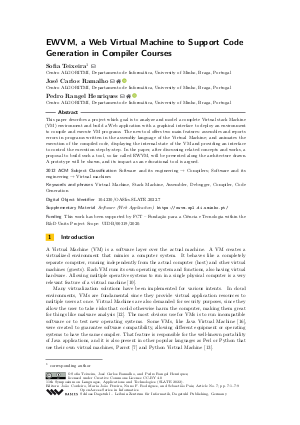EWVM, a Web Virtual Machine to Support Code Generation in Compiler Courses
Authors
Sofia Teixeira,
José Carlos Ramalho  ,
Pedro Rangel Henriques
,
Pedro Rangel Henriques 
-
Part of:
Volume:
11th Symposium on Languages, Applications and Technologies (SLATE 2022)
Part of: Series: Open Access Series in Informatics (OASIcs)
Part of: Conference: Symposium on Languages, Applications and Technologies (SLATE) - License:
 Creative Commons Attribution 4.0 International license
Creative Commons Attribution 4.0 International license
- Publication Date: 2022-07-27
File

PDF
OASIcs.SLATE.2022.7.pdf
- Filesize: 0.75 MB
- 9 pages
Document Identifiers
Subject Classification
ACM Subject Classification
- Software and its engineering → Compilers
- Software and its engineering → Virtual machines
Keywords
- Virtual Machine
- Stack Machine
- Assembler
- Debugger
- Compiler
- Code Generation
Metrics
- Access Statistics
-
Total Accesses (updated on a weekly basis)
0Document
0Metadata
Abstract
This paper describes a project which goal is to analyze and model a complete Virtual stack Machine (VM) environment and build a Web application with a graphical interface to deploy an environment to compile and execute VM programs. The new tool offers two main features: assembles and reports errors in programs written in the assembly language of the Virtual Machine; and animates the execution of the compiled code, displaying the internal state of the VM and providing an interface to control the execution step-by-step. In the paper, after discussing related concepts and works, a proposal to build such a tool, so far called EWVM, will be presented along the architecture drawn. A prototype will be shown, and its impact as an educational tool is argued.
Cite As Get BibTex
Sofia Teixeira, José Carlos Ramalho, and Pedro Rangel Henriques. EWVM, a Web Virtual Machine to Support Code Generation in Compiler Courses. In 11th Symposium on Languages, Applications and Technologies (SLATE 2022). Open Access Series in Informatics (OASIcs), Volume 104, pp. 7:1-7:9, Schloss Dagstuhl – Leibniz-Zentrum für Informatik (2022)
https://doi.org/10.4230/OASIcs.SLATE.2022.7
BibTex
@InProceedings{teixeira_et_al:OASIcs.SLATE.2022.7,
author = {Teixeira, Sofia and Ramalho, Jos\'{e} Carlos and Henriques, Pedro Rangel},
title = {{EWVM, a Web Virtual Machine to Support Code Generation in Compiler Courses}},
booktitle = {11th Symposium on Languages, Applications and Technologies (SLATE 2022)},
pages = {7:1--7:9},
series = {Open Access Series in Informatics (OASIcs)},
ISBN = {978-3-95977-245-7},
ISSN = {2190-6807},
year = {2022},
volume = {104},
editor = {Cordeiro, Jo\~{a}o and Pereira, Maria Jo\~{a}o and Rodrigues, Nuno F. and Pais, Sebasti\~{a}o},
publisher = {Schloss Dagstuhl -- Leibniz-Zentrum f{\"u}r Informatik},
address = {Dagstuhl, Germany},
URL = {https://drops.dagstuhl.de/entities/document/10.4230/OASIcs.SLATE.2022.7},
URN = {urn:nbn:de:0030-drops-167535},
doi = {10.4230/OASIcs.SLATE.2022.7},
annote = {Keywords: Virtual Machine, Stack Machine, Assembler, Debugger, Compiler, Code Generation}
}
Author Details
- Centro ALGORITMI, Departamento de Informática, University of Minho, Braga, Portugal
Funding
This work has been supported by FCT – Fundação para a Ciência e Tecnologia within the R&D Units Project Scope: UIDB/00319/2020.
Supplementary Materials
- Software (Web Application) https://ewvm.epl.di.uminho.pt/
References
-
Alfred V. Aho, Ravi Sethi, and Jeffrey D. Ullman. Compilers Principles, Techniques and Tools. Addison-Wesley, 1986.

-
Sameer M AlNajdi, Malek Q Alrashidi, and Khalid S Almohamadi. The effectiveness of using augmented reality (ar) on assembling and exploring educational mobile robot in pedagogical virtual machine (pvm). Interactive Learning Environments, 28(8):964-990, 2020.

- Tom Chothia and Chris Novakovic. An offline capture the flag-style virtual machine and an assessment of its value for cybersecurity education. In 2015 USENIX Summit on Gaming, Games, and Gamification in Security Education (3GSE 15), Washington, D.C., August 2015. USENIX Association. URL: https://www.usenix.org/conference/3gse15/summit-program/presentation/chothia.
-
Brian Davis, Andrew Beatty, Kevin Casey, David Gregg, and John Waldron. The case for virtual register machines. In Proceedings of the 2003 workshop on Interpreters, virtual machines and emulators, pages 41-49, 2003.

-
Simão Melo de Sousa. Máquina Virtual para o projecto da disciplina de compiladores. Dep. de Informática, Universidade da Beira Interior, Covilhão, Portugal, September 2006.

- Joseph A. Driscoll, Ralph M. Butler, and Joelle M. Key. A virtual machine environment for teaching the development of system software. In Proceedings of the 42nd Annual Southeast Regional Conference, ACM-SE 42, pages 440-441, New York, NY, USA, 2004. Association for Computing Machinery. URL: https://doi.org/10.1145/986537.986647.
-
Fabian Fagerholm. Perl 6 and the parrot virtual machine, 2005.

-
Nuno Gaspar and Simão Melo de Sousa. WebVm - A web-based host platform for pedagogical virtual machines. Special issue of the journal Informática na Educação: teoria & prática, 1(4), January/June 2009.

- Xuelian Hu and Dong Han. The design, implementation and application of minijava/ad as an object-oriented compiler teaching model. In 2009 4th International Conference on Computer Science Education, pages 1488-1491, 2009. URL: https://doi.org/10.1109/ICCSE.2009.5228571.
- IBM Cloud Education. Virtual machines. https://www.ibm.com/cloud/learn/virtual-machines, June 2019. Accessed: 05-10-2021.
- Kexugit. Why have a stack?, November 2011. URL: https://docs.microsoft.com/pt-pt/archive/blogs/ericlippert/why-have-a-stack.
-
Anh M Nguyen, Nabil Schear, HeeDong Jung, Apeksha Godiyal, Samuel T King, and Hai D Nguyen. Mavmm: Lightweight and purpose built vmm for malware analysis. In 2009 Annual Computer Security Applications Conference, pages 441-450. IEEE, 2009.

- Michael Prantl. Python internals: An introduction, October 2020. URL: https://blog.sourcerer.io/python-internals-an-introduction-d14f9f70e583.
- Yunhe Shi, Kevin Casey, M. Anton Ertl, and David Gregg. Virtual machine showdown: Stack versus registers. ACM Trans. Archit. Code Optim., 4(4), January 2008. URL: https://doi.org/10.1145/1328195.1328197.
- Mark Vinod Sinnathamby. Stack based vs register based virtual machine architecture, and the dalvik vm, September 2012. URL: https://www.codeproject.com/Articles/461052/Stack-Based-vs-Register-Based-Virtual-Machine-Arch.
- Hasitha Subhashana. Understanding how java virtual machine (jvm) works, May 2021. URL: https://hasithas.medium.com/understanding-how-java-virtual-machine-jvm-works-a1b07c0c399a.
